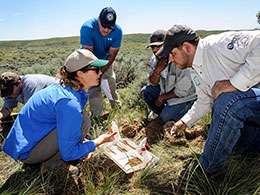Drilling pads for oil and gas development often exacerbate poor soil conditions

Lack of precipitation, short growing seasons and saline soils containing relatively few nutrients make for scant vegetation in Wyoming's high deserts.
For those same reasons, after those soils are disturbed to create drilling pads for oil and gas development, restoring the sites with native plants to outcompete noxious weeds is a significant challenge.
Researchers at the University of Wyoming are helping the energy industry gain new insights into the best approaches to reclaim areas disturbed by development. While no easy answers have emerged—no silver bullet to create fast-growing stands of desirable plants in the arid country—the research promises to maximize the ability of companies to restore disturbed lands for wildlife habitat and livestock grazing.
Samantha Day, a UW master's degree student in the Department of Ecosystem Science and Management, is nearing completion of a two-year project examining soil disturbance due to natural gas development in southern Wyoming. She is one of 24 graduate students studying through the UW School of Energy Resources' competitive graduate assistantship program, which attracts students from across the country to conduct research that benefits Wyoming's industries and economy.
Working under Associate Professor and UW Extension Soil Scientist Jay Norton, Day has found that excavation of drilling pads often exacerbates the region's poor soil conditions by stirring sodium into the topsoil. And removing that sodium and enhancing soil development through treatments—such as spreading gypsum, elemental sulfur and compost—is not a quick solution.
"When the soil is disturbed, it changes everything," says Day, who came to UW after earning a bachelor's degree in environmental science and chemistry at Virginia Tech University. "Reclaiming lands in this difficult environment takes much longer than you might think."
But Day's research has found some glimmers of hope.
First, she says, if companies can successfully separate topsoil material from salty and high-clay subsurface material during well pad construction, they can minimize the amount of sodium stirred into the root zone.
"Being careful before disturbing the land is the best mitigation measure you can take," she says.
Second, there's not enough precipitation for traditional treatments such as spreading gypsum to be immediately effective, as water is needed to work the mineral into the soil. Day has found that treating the soil with a different mineral called langbeinite—which is more soluble than gypsum—offers greater potential to improve plant germination and growing conditions.
"It takes less water to become active, and there's more water movement in the soil," she says. "With langbeinite, there should be more reward in less time."
Additionally, when topsoil is spread, it may be best to create a rougher surface instead of "a wheat field seedbed" look, Norton says, suggesting further study of the practice. That would allow for precipitation to pool in places, likely creating conditions more suitable for soil development.
Finally, when areas are reseeded, the seed mixes could include more "aggressive native plants" to put up a first line of defense against noxious weeds as a sort of native cover crop—another technique worthy of study—Norton says.
"If you can start with a desirable cover of annual native plants, then you set the stage for a long-term cover with other native plants," he says.
Day conducted her research on drilling sites in the Wamsutter area in cooperation with BP and its reclamation contractor. "Proxy" plots using Wamsutter-area soil also were grown in wooden boxes near the UW greenhouse in Laramie.
Norton says Day's research has set the stage for further exploration of soil development, such as experimenting with the rates at which treatments are applied.
"We're just trying to speed along soil development and redevelop the germination zone," Norton says, "so that something other than weeds will germinate."
Tony Attardo, BP's Wyoming Basin manager, says the company looks to the findings of Day and other UW researchers at the Wyoming Reclamation and Restoration Center to help advance reclamation science responsibilities at its Wamsutter-area operations.
"BP has a long-standing relationship working with the University of Wyoming Reclamation and Restoration Center in developing best practices and sound science for reclamation in southwestern Wyoming," Attardo says.
Provided by University of Wyoming





















